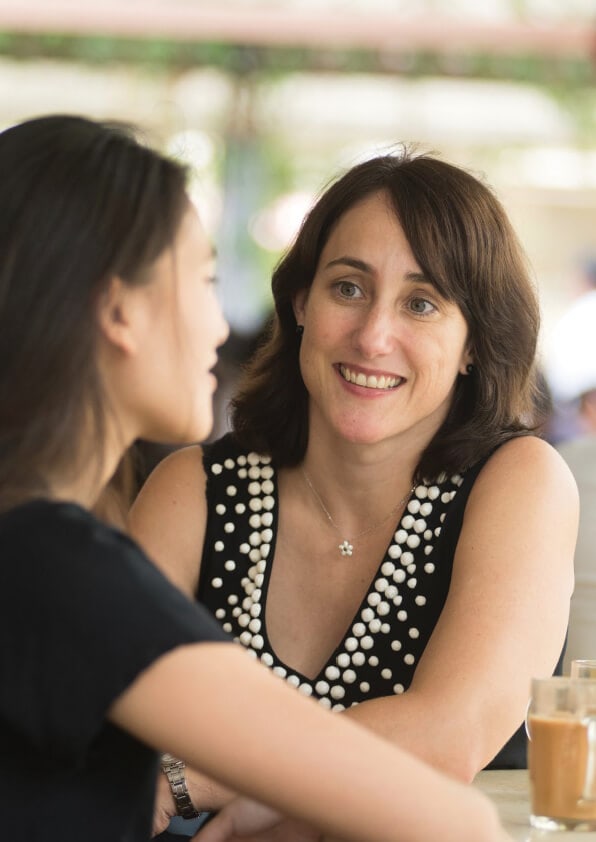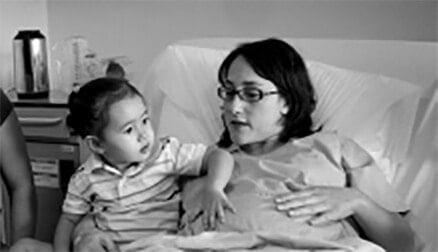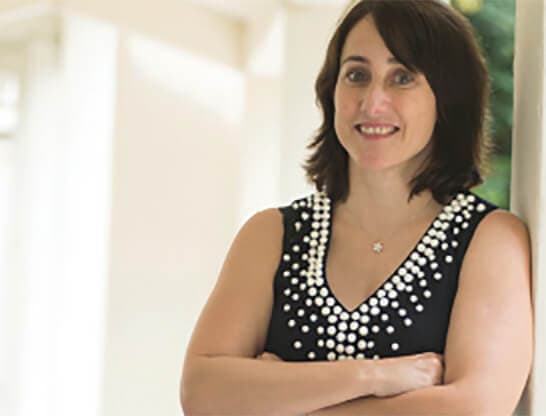
Diagram magazine catches up with Bridgit O’Donovan, a mother of two, who shares what it’s like to survive eclampsia. Her experience embodies the urgent, unmet need for better predictive diagnostics in preeclampsia to save lives of both mothers and their unborn babies.
Bridgit O’Donovan woke up early on a Sunday with a feeling that something was very wrong. She was almost 30 weeks pregnant. She woke her husband up and tried to tell him she was feeling unwell. But the words came out garbled. “I wasn’t making any sense. I lost my eyesight. I remember Alan saying, ‘I’m over here’ and I said, ‘I can’t see you.’ My daughter came into the room calling for me and I couldn’t see her either.” Her husband drove her to the hospital where the doctors found her blood pressure had ratcheted up to 171/106: she was having a seizure.
Bridgit was diagnosed with eclampsia and rushed in for an emergency C-section, which saved her life.
Preeclampsia is a complex and multisystem pregnancy disorder that causes 15% of all premature births1 and 42% of all maternal deaths worldwide.2 The condition involves reduced blood flow from the placenta and inadequate oxygen and nutrients to the foetus which, if left undetected, can lead to serious health consequences for both mother and baby. In developing countries, the disease kills nearly 70,000 women each year.3
“I was lucky that we got to the hospital when we did because they stabilised me quickly.” Bridgit lives in Singapore, a highly developed country well known for its healthcare infrastructure. Bridgit’s undetected preeclampsia progressed rapidly to eclampsia, a rare complication marked by seizures and sometimes, a fatal coma. An MRI showed no brain damage from the seizure. Her son, Leo, who was born premature and a little bigger than her palm, was also fortunate. “He looked like a kitten, his skin was translucent and his eyes had yet to form pigments but he was just a perfect, tiny person,” Bridgit said.
Success stories of early detection of preeclampsia are rare as the condition is notoriously difficult to diagnose. Many of the early symptoms resemble the normal effects of pregnancy on the body like nausea, vomiting and rapid weight gain. This is why preeclampsia has earned the nickname, ‘the great imitator.’ Other symptoms include severe headaches, abdominal pain and vision changes. Standard diagnosis involves detecting high blood pressure after 20 weeks and protein in the urine.4 Approximately 80% of pregnant women with signs of preeclampsia do not develop the condition.5 So physicians face the dilemma of unnecessarily hospitalising a woman and causing stress and alarm. Left undetected, preeclampsia causes complications such as haemorrhaging, multiple organ failure and stroke.

As a healthy and active 36-year-old, Bridgit noticed that her second pregnancy seemed nothing like her first. “My first was so normal I didn’t even have morning sickness.” But with the second, she just didn’t feel well. At 14 weeks, she was diagnosed with placental notches and Intrauterine Growth Restriction (IUGR). This means the foetus is behind its gestational age in terms of size and development.
Bridgit’s doctor prescribed mini aspirins and told her the goal was to get to 26 weeks for a viable pregnancy. She had weekly check-ups to monitor that the baby was growing normally. “At every check-up, there was nothing to suggest any serious issues. My blood pressure was higher than normal at 140/90. My doctor said it was stable and I didn’t need to worry,” she added.
Bridgit was working full-time as a communications professional. She had headaches but they’d come and go. Just before week 29, Bridgit stopped working as she felt too tired and had experienced a sudden pain in her diaphragm while pushing her daughter’s stroller to school. In retrospect, there were many symptoms that she attributed to normal pregnancy discomfort in Singapore’s muggy heat. She regrets that she wasn’t more confident in her own instinct that things weren’t quite right: “I was embarrassed to ask too many questions. We rely on our doctors to tell us when something is wrong but they only know when you tell them. If I had asked, what should I look out for given that I have an IUGR baby? Then, my doctor could have said, ‘If you have any of these symptoms, come straight to the clinic.’ Nurses have a role to play too. When I called and said I had a headache, they should have said, she has an IUGR baby and she should come to the clinic and check it out.”
These sort of missed signals underline the urgent need to expand current diagnostic criteria and reduce the number of preeclampsia-related deaths. Over the last two decades, scientists have identified two new biomarkers with the potential to transform how the disease is detected, monitored and treated. Based on the discovery, Roche has developed a new preeclampsia test that measures a ratio of two proteins found in the mother’s blood. The test can predict which pregnant women with suspected preeclampsia will and will not develop the condition, with greater certainty than standard diagnostics. This paves way for more success stories of preeclampsia detection as it gives doctors the confidence to send healthy women home safely and to prioritise treatment for women who are more likely to develop the condition.
Bridgit wishes that her risk had been detected earlier and that she had been able to avoid a major traumatic event in her life. “People say that preemie babies will catch up but I know that Leo will always be on the smaller side. He was born with a hole in his heart that solved itself. But he still needs a lot of care and a kind of high-intensity parenting,” she said.
There is an urgent need to expand current diagnostic criteria and reduce the number of preeclampsia related deaths.
Bridgit recently celebrated her 40th birthday but the frightening experience of eclampsia stays with her. “I’m still quite emotional about it. It took me a while to share the joy of a normal pregnancy with my friends who got pregnant around the same time as I did. I was grieving for the loss of my pregnancy and the fact that my child is not 100% healthy.” Bridgit stopped working for about two years to focus on building back her strength and caring for Leo. Seeing her son get better, stronger and grow into a talkative 3 year-old has been a healing experience, she said.

Bridgit is also channeling her trauma into creating more awareness for preeclampsia. When she reads an interesting article about the disease, she shares it through her Facebook and Twitter accounts. “Many pregnant women and their partners are told not to be paranoid. I want women to feel powerful in knowing their bodies and asking questions when something feels wrong.” She shared that women have reached out to her and discussed what to ask their doctors and what to look out for. “This is great – because being pregnant is serious business. Enjoy the baby shower but do your homework and be prepared to be your own advocate,” she said.
References:
¹Goldenburg, R.L., Rouse, D.J. 1998. NEJM 339:313- 320.
²Verlohren, S., et al. 2010. Am J Obstet Gynecol 202(161):e1-11.3.
³http://www.who.int/mediacentre/news/releases/release44/ en/. Last accessed in September 2016.
⁴Wagner, L.K. 2004. Am Fam Physician 70(12):2317- 2324.
⁵Zeisler, H., et al. 2016. NEJM 374:13-22.














